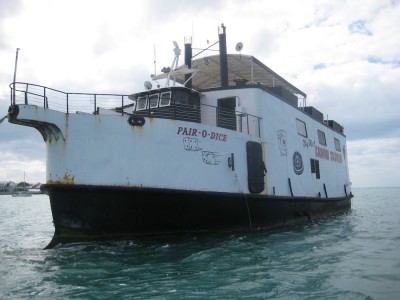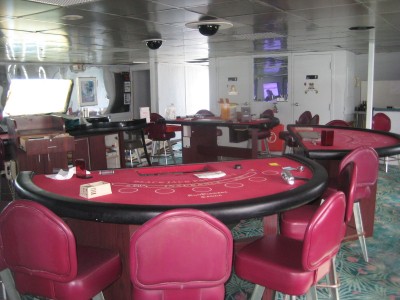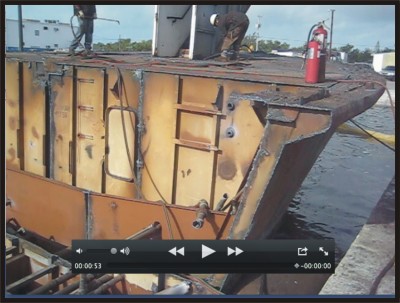The Demise of Casino Boat “Pair-O-Dice”
Could the seizure and destruction of the casino boat “Pair- O-Dice” open the County up to liability comparable to the 8 Million dollar Duck Tour fiasco?
After the County spent around $ 125,000 in 2009 cutting the “Pair O Dice” into pieces and reducing it to a heap of scrap metal, a Monroe County Judge, last December, finally dismissed the criminal charges against the Casino boat operator Mickey Marrone.
Marrone was arrested on March 20, 2009 after his Casino boat, anchored in Key West harbor, broke loose and ran aground on Sunset Key. He was charged with criminal abandonment of the “Pair-O-Dice”.
“We called the owner,” says Captain David Dipre of FWC, “We told him his boat was on the beach. He said there was nothing he could do about it.”
“Yes, they called me,” says Marrone, “they said if I did not remove the boat right away they would have Towboat US take it to Robby’s Marina on Stock Island. I said O.K. let’s do that because I had no way of doing anything myself at that moment.”
“The biggest problem,” says Captain Dipre, “is that once the boat was at the dock he still would not take care of it and pay the dockage.”
“Are you kidding me,” says Marrone, “they negotiated a dockage agreement at Robbie’s Marina for $ 750.00 per day! Who can pay that much for an 85-foot boat? I used to pay a couple of thousand a month.”
Marrone says there was no way he could keep up with that kind of charge.
“So, I found someone to buy the boat,” says Marrone, “and I had an estimate for what I could get from a distress sale by an auctioneer for between $ 75,000 and $ 100,000 and maybe even more, he said, if he had more time to advertise.”
“Everything was going along fine with the buyer; we were signing the paperwork. I get to the dock; the boat is gone. It’s across the water at some other dock being cut up into pieces. It was like science fiction,” says Marrone, describing ten or twenty people with cutting torches and cranes taking the boat apart.
“Pair-O-Dice” was a steel boat that, according to Marrone, had been re-plated at Jones Boatyard in Miami just five years earlier in 2004. A payment had just been made to close out a $ 26,000 lien on the boat. (We verified that the Abstract of Title shows the lien had indeed been extinguished just a few weeks before the boat ran aground and was dismantled.)
So what happened?
Well, to really understand this case one needs to go back in time, before the boat was impounded, before it ran aground, even before Mickey Marrone had even thought of running a Casino Boat called the “Pair-O-Dice”.
Marrone with his free-thinking ways and his deep pocket connections has been a thorn in the side of the State for over 20 years. It all started when he was living in a floating ‘palace’ on Houseboat Row over on South Roosevelt Boulevard.
His lawyers were fighting the efforts of the State to evict the row of quaint looking houseboats that had tied up to the seawall on South Roosevelt. To garner support they tapped into the charm of the picturesque houseboats with dreamy names such as “A Chance To Dance In France”, and through a referendum obtained the right to be relocated to a marina tailored for them at Garrison Bight.
Next Marrone decided to get into the Casino boat business.
“It was a great idea,” says Marrone. He found an old riverboat and had it refitted in Miami at Jones Boatyard. He red-carpeted the floor, installed mirrors on the ceiling, a hundred slot machines on the first deck and black jack tables on the second floor. But the ultimate trick of the trade was the discovery of an amazing geographical no man’s land; a triangle of open ocean just three miles off the coast of Key West.
“It was as if someone had given you a treasure map,” says Marrone, “Right there between Fort Zack and Sand Key, in well-protected waters, was this small area just big enough for the boat where Florida law did not apply. Don’t ask me why it is like that, but there it was.”
Every night the “Pair-O-Dice” would leave the dock with a bright row of smartly dressed gamblers and power over to their little loophole. As soon as the anchor would hit bottom, all the slot machines would suddenly come alive with the sound of techno music. Everyone would cheer; the Casino was open for business!
“It was a great business,” says Marrone. “I think we should have worked on the entertainment,” says Michael Marrone, Micky’s son. “We should have had Dancers’ Night.” (And by ‘dancers’, Michael, who is not in his 20’s for nothing, means strippers).
The problem with a small casino is that you can have one lucky guy break the bank one night and take all the profits of the week and if it happened more than once a month you could get into serious trouble.
In the end, the troubles didn’t come from the black jack tables but from the guts of the boat itself. Maintenance was expensive. The real owner of the boat (Micky being the Casino operator) a man called Richard Marrigan who lives in Boxford, Massachusetts, got tired of dumping money into the rusty old lady. When the generator broke down Merrigan refused to have it fixed.
Beginning in 2005 the boat remained idle at anchor between Wisteria Island and Sunset Key. That’s when it took up the bad habit of going for a cruise all on its own. Which is how I first met Marrone. I was running a salvage boat. The Coast Guard reported the “Pair-O-Dice” adrift in the Northwest Channel. It was a ‘dark and stormy night.’ We put a line on the boat and towed it back. It was so rough with that huge boat in tow that my crew fell on the winch and broke two ribs.
The next morning I went to see the famous Mickey Marrone. I was introduced into his Italian bedroom were he was laying on his golden sculpted bed in his satin crimson bathrobe. Marrone is a rather large man; it was a scene out of the Godfather. There were gold curtains and I sat on a gold chair and asked him for money.
He listened to my story and said, “What you are sayin’ is you did me a fava”.
“That’s right and my crew broke his rib.”
“And because you said what you said, I have not thrown you out the door. Comin’ here askin’ ME for money!” said Marrone.
He would ultimately pay for both the work and the hospital bill, which is more than many other people around here would do.
But then the boat broke loose again during another storm. This time it went across the harbor and inside Truman Annex where miraculously the 300 ton steel boat docked itself real nice on some pilings . The problem was that on the other side of the pilings were a bunch of color-coordinated, beautiful NOAA and FWC patrol boats.
“When the ‘girlfriends’ saw what could have happened,” says Michael, “they kind of passed a fur ball if you see what I mean.”
After the boat was re-anchored, it took on water and almost sunk and then, unbelievably, three weeks later it broke lose again and ran aground on Sunset Key.
By that time FWC had run out of patience. They had the County destroy the boat 4 weeks later.
This is where the opinions diverge – FWC says they had to destroy the boat so quickly because of the dockage fees, but according to Marrone, the $ 750/day bill for dockage was part of a plot to make sure the boat was not going to return to Key West. Marrone believes FWC rushed to have the boat destroyed when they were informed the cursed steel monstrosity was being sold in order to be put back in business.
And here’s where we come to the core of the legal peril facing Monroe County, which is the arm of the State that administers the destruction of derelict vessels.
Florida law doesn’t require any form of judicial review before the seizure and destruction of a boat. Now if there is one thing that is clearly written in the Constitution it is the right not to be deprived of property without due process of law.
As to what ‘due process’ means, the Supreme Court has emphatically repeated that it requires a meaningful opportunity to be heard. Marrone certainly didn’t receive an opportunity to bring to the attention of a Judge that he was selling the boat, that the dockage was too costly, nor any other claims that might have given him the means to save his investment.
In a very similar case the Supreme Court for the State of Hawaii found the seizure and destruction of a vessel unconstitutional where the owner didn’t receive notice of an opportunity for a hearing prior to the destruction of his boat.
That vessel, a trimaran anchored in Honolulu Harbor, was found taking on water. The Harbor Master, an officer of the State, decided to impound the boat and haul it out of the water. Duncan Brown, the owner, and the Harbor Master entered into a disagreement as to the cost of the impoundment, with Brown refusing to pay and then leaving on a temporary voyage. In the meantime the Harbor Master had the boat destroyed. Brown sued for violation of his civil rights.
The Hawaii Supreme Court ruled that Brown should have been provided with a hearing prior to the destruction of his boat.
“While the January 3, 1994 letter to Brown informed him of the impoundment and possible disposal of vessel 7430, the letter made no mention of ‘procedures available for challenging that action’, administrative or otherwise. Accordingly Brown did not receive adequate notice regarding the impoundment of vessel 7430. Furthermore, Brown was never provided with an opportunity to be heard on the matter of the vessel 7430’s impoundment.”
– Brown v. Thompson, et al., No. 21528 (Civ. No. 93-2918-07) July 7, 1999
Now, if Marrone’s constitutional right to due process has been violated, does this mean he (and the vessel owner Merrigan) could sue the County for the loss of the boat?
“I am definitely going to sic the lawyers on this one,” says Marrone.
Not only might the County not recoup the $ 125,000 or so it spent destroying the boat, but it could end up buying Marrone and Merrigan another boat.
Could they also sue for loss of business, or worse, like the Duck Tours, for the loss of future business? After all, even thought the Duck Tours was making little money, the owners were able to convince a jury that they would have made millions with their amphibious tour boats had the City not put them out of business. The City of Key West ended up having to pay an $8 Million settlement to the Duck Tour owners after a Federal Court found the City had violated the owners’ civil rights.
“The statute doesn’t provide for a hearing, but FWC is enforcing the law,” says Captain Dipre, “We cannot make the law.”
At this point the State is appealing the Court’s decision to dismiss the criminal case against Marrone.
County Judge Peary Fowler found that Marrone and FWC had made an arrangement to have a towing company remove the boat and that once the boat was at a private dock it was no longer abandoned in public waters and thus Marrone was not in violation of the derelict vessel statute.
As to the $ 125,000 of disposal costs, the Judge ruled it was a civil matter between the State, the County and the owner of the Pair-O-Dice.
“If someone wants to challenge the constitutionality of the derelict vessel statute, that is not something that concerns me,” says Captain Dipre. “FWC enforces the law as it is, not as it could or should be.”
But the derelict vessel statute, despite all its good intentions, has deprived many people of their property and they were not all rich casino owners. Many have found themselves homeless on the streets of Key West.
“I have never been able to have my own place again,” says Kenneth Campanay, whose boat was destroyed after he was arrested in June 2010 under the derelict vessel statute, because the boat’s engine didn’t run. It was a good boat says Campanay who has lived at KOTS Homeless Shelter ever since. Could he have convinced a Judge to give him more time, more slack? Who knows.
He admits the FWC gave him plenty of notice and time, but according to the Constitution, he too should have been entitled to speak to a Judge.


